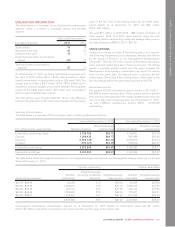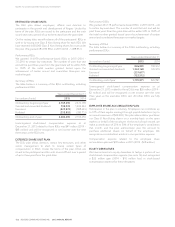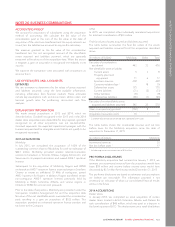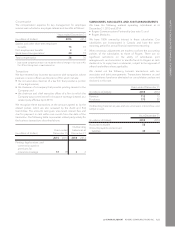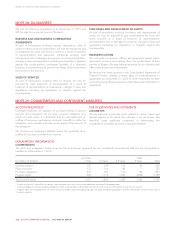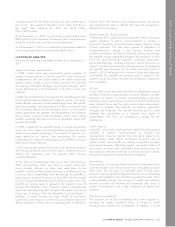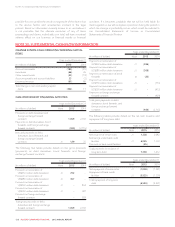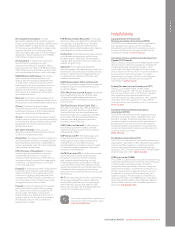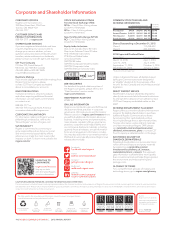Rogers 2015 Annual Report Download - page 143
Download and view the complete annual report
Please find page 143 of the 2015 Rogers annual report below. You can navigate through the pages in the report by either clicking on the pages listed below, or by using the keyword search tool below to find specific information within the annual report.
2015 ANNUAL REPORT ROGERS COMMUNICATIONS INC. 141
LTE (Long-Term Evolution): A fourth
generation cellular wireless technology (also
known as 4G) which has evolved and enhanced
the UMTS/HSPA+ mobile phone standards.
LTE improves spectral efficiency, lowers costs,
improves services, and, most importantly,
allows for higher data rates. LTE technology is
designed to deliver speeds up to 150 Mbps
with further increases over time.
LTE Advanced: A mobile communication
standard which represents a major
enhancement of the LTE standard. With a
peak data rate of 1 Gbps, LTE Advanced also
offers faster switching between power states
and improved performance at the cell edge.
M2M (Machine to Machine): The wireless
inter-connection of physical devices or
objects that are seamlessly integrated into
an information network to become active
participants in business processes. Services
are available to interact with these ‘smart
objects’ over the Internet, query, change
their state and to capture any information
associated with them.
Near-net: Customer location(s) adjacent to
network infrastructure allowing connectivity to
the premises to be extended with relative ease.
Off-net: Customer location(s) where
network infrastructure is not readily available,
necessitating the use of a third-party leased
access for connectivity to the premises.
On-net: Customer location(s) where network
infrastructure is in place to provide connectivity
to the premises without further builds or third
party leases. An on-net customer can be
readily provisioned.
OTT (Over-the-Top): Audio, visual, or
alternative media distributed via the Internet
or other non-traditional media.
Penetration: The degree to which a product or
service has been sold into, or adopted by, the
base of potential customers or subscribers in
a given geographic area. This value is typically
expressed as a percentage.
POPs (Persons of Population): A wireless
industry term for population or number
of potential subscribers in a market, a
measure of the market size. A POP refers to
one person living in a population area, which,
in whole or in substantial part, is included
in the coverage areas.
Postpaid: A conventional method of payment
for wireless service where a subscriber pays
a fixed monthly fee for a significant portion
of services. Usage (e.g. long distance) and
overages are billed in arrears, subsequent to
consuming the services. The fees are usually
arranged on a term contract basis.
Prepaid: A method of payment for wireless
service that allows a subscriber to prepay
for a set amount of airtime in advance of
actual usage. Generally, a subscriber’s
prepaid account is debited at the time of
usage so that actual usage cannot exceed
the prepaid amount until an additional
prepayment is made.
PVR (Personal Video Recorder): A consumer
electronics device or application software that
records video in a digital format. The term
includes set-top boxes with direct-to-disk
recording facility, which enables video capture
and playback to and from a hard disk.
Set-Top Box: A standalone device that receives
and decodes programming so that it may
be displayed on a television. Set-top boxes
may be used to receive broadcast, cable, and
satellite programming.
Spectrum: A term generally applied to
electromagnetic radio frequencies used in the
transmission of sound, data and video. Various
portions of spectrum are designated for use
in cellular service, television, FM radio, and
satellite transmissions.
SVOD (Subscription Video on Demand):
Offers, for a monthly charge, access to specific
programming with unlimited viewing on an
on-demand basis.
TPIA (Third-Party Internet Access): Wholesale
high-speed access services of large cable
carriers that enable independent service
providers to offer retail Internet services to their
own end-users.
TSU (Total Service Unit or Cable TSU): In
the cable TV industry, this refers to television,
Internet, and cable telephony subscribers.
A subscriber that has purchased television
and Internet services is counted as two TSUs.
A subscriber that has purchased television,
Internet, and cable telephony services is
counted as three TSUs, etc.
VOD (Video on Demand): A cable service
that allows a customer to select and view
movies and shows at any time from a library
of thousands of titles.
VoIP (Voice over IP): The technology used
to transmit real-time voice conversations
in data packets over a data network using
Internet Protocol. Such data networks
include telephone company networks, cable
TV networks, wireless networks, corporate
intranets, and the Internet.
VoLTE (Voice over LTE): A platform to provide
voice services to wireless customers over
LTE wireless networks. The LTE standard
only supports packet switching as it is all
IP-based technology. Voice calls in GSM are
circuit switched, so with the adoption of LTE,
carriers are required to re-engineer their voice
call network, while providing continuity for
traditional circuit-switched networks on 2G and
3G networks.
Wi-Fi: The commercial name for a networking
technology standard for wireless LANs that
essentially provide the same connectivity as
wired networks, but at lower speeds. Wi-Fi
allows any user with a Wi-Fi-enabled device to
connect to a wireless access point.
Helpful Links
Canadian Radio-Television and
Telecommunications Commission (CRTC)
The CRTC is an independent public organization
that regulates and supervises the Canadian
broadcasting and telecommunications systems.
It reports to Parliament through the Minister of
Canadian Heritage. www.crtc.gc.ca
Innovation, Science and Economic Development
Canada (ISED Canada)
ISED Canada is a ministry of the federal government
whose mission is to foster a growing, competitive,
knowledge-based Canadian economy. It also
works with Canadians throughout the economy
and in all parts of the country to improve conditions
for investment, improve Canada’s innovation
performance, increase Canada’s share of global
trade, and build an efficient and competitive
marketplace. www.ic.gc.ca
Federal Communications Commission (FCC)
The FCC is an independent United States
government agency. The FCC was established by
the Communications Act of 1934 and is charged
with regulating interstate and international
communications by radio, television, wire, satellite,
and cable. The FCC’s jurisdiction covers the 50
states, the District of Columbia, and U.S. territories.
www.fcc.gov
Canadian Wireless Telecommunications
Association (CWTA)
The CWTA is the industry trade organization and
authority on wireless issues, developments, and
trends in Canada. It represents wireless service
providers as well as companies that develop and
produce products and services for the industry,
including handset and equipment manufacturers,
content and application creators, and business-to-
business service providers.
www.cwta.ca
The Wireless Association (CTIA)
The CTIA is an international non-profit membership
organization, founded in 1984, representing wireless
carriers and their suppliers, as well as providers
and manufacturers of wireless data services and
products. The CTIA advocates on their behalf before
all levels of government. www.ctia.org
GSM Association (GSMA)
The GSMA is a global trade association representing
nearly 800 operators with more than 250 companies
in the broader mobile ecosystem, including
handset and device makers, software companies,
equipment providers, and Internet companies, as
well as organizations in adjacent industry sectors.
In addition, more than 180 manufacturers and
suppliers support the Association’s initiatives as
associate members. The GSMA works on projects
and initiatives that address the collective interests
of the mobile industry, and of mobile operators in
particular. www.gsma.com
GLOSSARY
For a more comprehensive glossary of
industry and technology terms, go to
rogers.com/glossary


